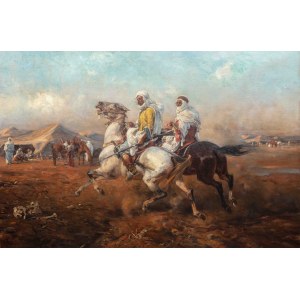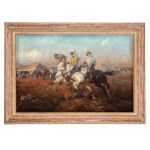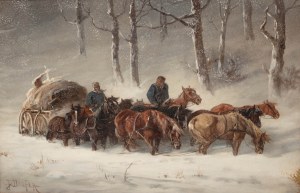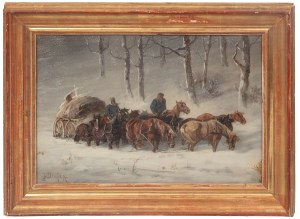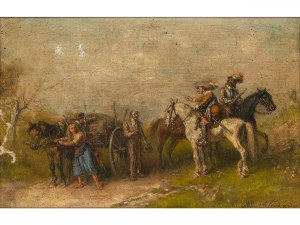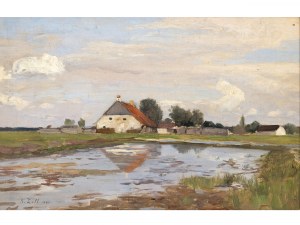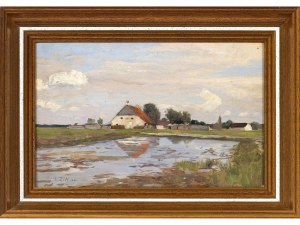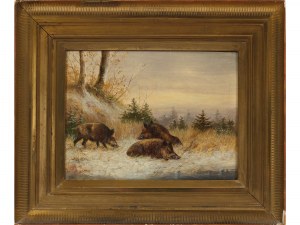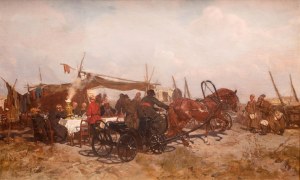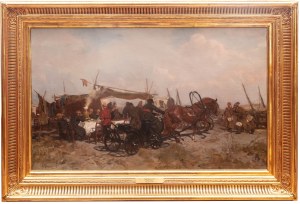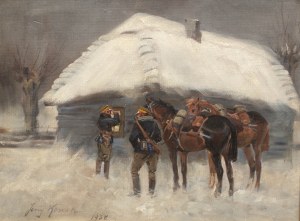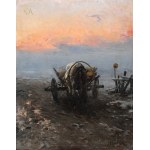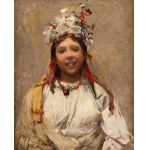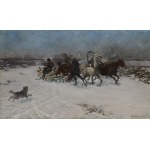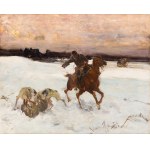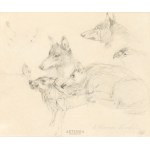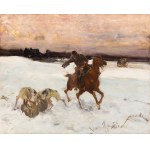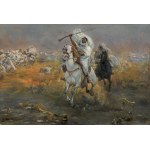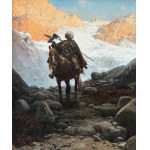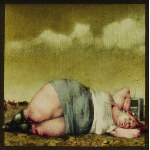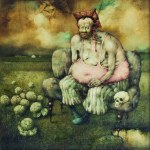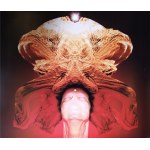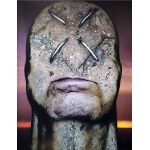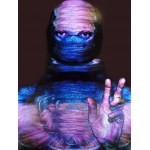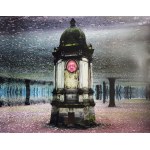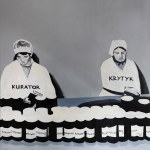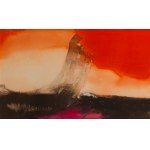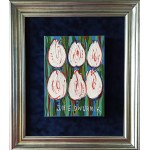oil, canvas, 73 × 109 cm
Signed l. d.: "A Wierusz-Kowalski"
Provenance
- 1906 - Heinemann Gallery, Munich
- 1910 - George Ehret jr., New York
- 2023 - private collection
Reproduced:
- Galerie Heinemann catalog, 1910, Munich
Attached to the painting is the expert opinion of Ms. Eliza Ptaszyńska (expert and author of many publications devoted to the work of Alfred Wierusz- Kowalski, curator of the District Museum in Suwałki in possession of an extensive collection of "Wieruszians").
"And here I saw great talent. There was character in these paintings, there was a lot of life."
Olga Boznańska on Wierusz-Kowalski's paintings, October 1938,
A. Nowaczynski, "U Olga Boznanska w Paryżu," Tygodnik Ilustrowany 1938, no. 42, p. 806.
"Alfred Wierusz-Kowalski, after a stay of several months in Africa, returned to Warsaw yesterday. The outstanding artist will only stay a few days within the walls of our city, after which he will leave for a longer period of time for Munich. Prof. Wierusz-Kowalski took advantage of his stay in Africa to gather rich material, which he will now use to paint pictures based on themes of great interest to art."
Kurier Warszawski 1903, no. 112, p. 8 of April 11 (24).
"An inseparable element of Wierusz-Kowalski's genre-landscape paintings are horses, those noble and useful animals which have been held in great sentiment by Poles for centuries. The artist was able to depict horses in a variety of situations, shots and abbreviations, showing an incredible knowledge of the shape, character and movement of the horse." J. Zielińska, Native motifs in the works of
Alfred Wierusz-Kowalksi, [in:] Z. Faltynowicz [ed.], "Studies, sketches, recollections about Alfred Wierusz-Kowalski", Suwałki 2000, p. 64.
The paintings of Alfred Wierusz-Kowalski, considered one of the most outstanding representatives of the Polish circle of artists active in Munich, anchored by their motifs in the world of the
Orient, extremely rarely appear on the auction market. And of this class, as the work presented at the auction, they were practically not listed for sale in Poland. In the camp it impresses with its dynamism, animation, freedom. Here the artist has taken care of the balance between cool and warm colors, although the painting seems to breathe hot and dry, even jittery desert air. In the first close-up, bones, dried branches and blades of grass lie on the dry brown ground. In the central part of the painting are two horsemen, on a grey and a black horse The men are dressed in jalabiyas, wearing yellow and red kaftans, with white kephiyas on their heads and shoulders, in the man on the right a kephiyah supported on his head by an agal. The left horse paused in the rush raised upwards on its hind legs. Steeds treated with swagger, the dust has yet to settle. In the second and third planes, the complete opposite - an oasis of Bedouin tranquility and the immensity of space of the rocky-sandy desert landscape.
"Reaching far into the representation, the ground plane has been painted in warm ochres with reflections of golds and reds. Lighter by two tones are the clouds of dust raised by the Arabs entering the encampment. They hover, right behind the horsemen, over the roofs of the tents, obscuring the sky. The Arabs' kaftans, gold and carmine, are the color keystones of the composition. They balance and tint with warm reflections the cool coils of white enveloping the men, the gray and metallic sheen - bay - of the horses' coats. Scattered flashes of red, blue, white attract the viewer's eye, prompting him to look carefully at selected details, pinning down the whole picture in color. A spot of red on the head of the figure in the far background, a reflection of white on the rider's hand, or blue flecks on the burnus add brilliance to these highlighted parts of the painting. They draw attention to these peerless masterpieces of painting, muted, hidden somewhere far in the background, in the shadow of the dynamic foreground. The varied texture of Alfred Wierusz-Kowalski's paintings reinforced the effects the author achieved through the use of thoughtful composition, the expression and dynamics of the scene, its mood and the role of color. The close foreground of the painting, the surface of the earth, In the camp covered with brick-red sand, dried blades of plants, animal remains is realistically fleshy, material, thickly, impasto and vigorously painted. Traces of the use of putty, a thick, wide brush are visible. The coloring is dark, heavy. The further into the painting the smoother the painting surface becomes. Brush movements are longer, painting thinner, colors lose saturation, their harmony is greater, contrasts fade. The painting is light, laser-like. The camp slowly, as you watch, reveals the secrets of the artist's workshop. The author had an unparalleled talent for composition and such a keen sense of color. He was characterized by the ability to convey the essence of the world depicted, with its diverse and changeable matter, and had a gift for focusing the viewer's attention and conveying the emotions and mood contained in the depiction. Excellent drawing, color harmony, the play of light - in the painting in question scattered on particles of sand floating in the air - all this creates an ephemeral, wonderful world of Alfred Wierusz-Kowalski's sensitivity and talent written on canvas with a "speck of paint." (...) However the artist composed and painted this work using all the formal procedures developed over the years and brought to perfection, it has a freshness and ardor inherent in the author's best works. In his characteristic manner, he placed the main figural group in the foreground, in the center of the composition and on an oblique line directed slightly into the depths of the representation. Showing the horses slightly from behind and the gray horse piled up gives this part of the representation expression and dynamism, but at the same time both riders with their steeds are subjected to the viewer for inspection - they turn their bodies towards the viewer. This described play of figures and elements of the scene captures the artistry with which Alfred Wierusz-Kowalski composed his paintings. Every detail, gesture had a meaning in the construction of the scene and affected the viewer. Color played an equally important role in the artist's paintings in building the composition, directing the viewer's eye and creating the mood of the scene.
"In the Camp" is (...) a work striking in its beauty and truth of the world depicted. The magnificently painted sky, the freedom of the painting gesture, its lightness and certainty at the same time, the palpable energy and strength. We are undoubtedly dealing with a work of great artistic value." (excerpt from Eliza Ptaszynska's expert opinion)
In early 1903, Alfred Wierusz Kowalski, riding the wave of fashion for Orientalism, traveled to Morocco and Algeria. The turn of the 19th and 20th centuries was a time of increased fascination with the East (the Near and Far East, North Africa, but also the eastern or southern frontiers of Europe) in literature, music and perhaps above all in the fine arts of the old continent. Exhibitions at the time featured paintings with images of exotic beauties and warriors on horseback, depictions of harems, markets and mosque interiors. In 1893, the Société des Peintres Orientalistes Français was founded in Paris, an organization of artists dealing with oriental themes and promoting artists' travel to the Far East. Wierusz Kowalski, too, traveled to the Maghreb to refresh his artistic skills, gain new impressions and regain his painterly sensibility through exposure to exotic culture and landscape. The effect of Alfred Wierusz-Kowalski's African trip was precisely the painting "In the Camp." The work presented in the catalog in 1906 was purchased by the renowned Munich Heinemann Gallery, most likely directly from the artist. It is worth noting that it was Theobald Heinemann himself, one of the gallery's owners, who urged Kowalski to travel to Africa. (E. Ptaszyńska, "Alfred Wierusz-Kowalski 1849-1915," p. 167). In 1909, the painting was acquired for his collection by George Ehret Jr. a well-known New York brewer, owner of one of the largest American breweries at the turn of the 20th century.
Recently viewed
Please log in to see lots list
Favourites
Please log in to see lots list



